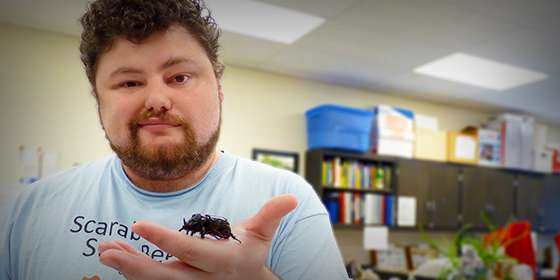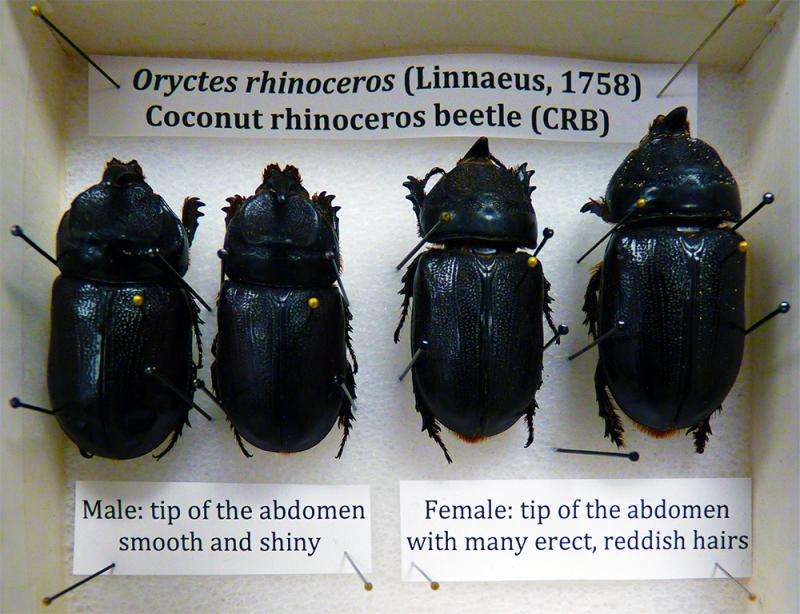Group works to save the destruction of the iconic palm tree

When a monster beetle arrived in Hawaii and began chomping down palm trees, students with Wichita State University's Bug Lab took action.
Oryctes rhinoceros, also known as coconut rhinoceros beetles, have already decimated 50 percent of coconut palms in Guam. It's an ecological and economic disaster that has now spread to Oahu in Hawaii and is likely to continue its march to other nearby tropical areas.
But WSU graduate students Josh Dunlap, Jackie Baum and Emmy Engasser – guided by assistant entomology professor Mary Liz Jameson – hope to stop the spread of this destructive species through the creation of a website and mobile app that helps the public identify the invasive pests and notify proper authorities.
The website and Hawaiian Scarab ID app, available for iPhone or Android, were developed in partnership with the U.S. Department of Agriculture. They were the brainchild of Dunlap as part of his master's thesis. Dunlap graduated from WSU in May and has since been hired full time at the USDA.
With 50,000 species of scarab beetles – most of which are not destructive and many of which are endangered – proper identification is the key.
"Unless you're really familiar with the species, they're easy to confuse," says Dunlap. "Since there were no other tools to help people identify pests from nonpests, we went ahead and worked with the USDA to create one."
Anyone who sees a beetle or its sizable larva, which makes its habitat in mulch, can use the app to identify it, browse images and videos, access resources and compare it with other scarabs. Identification is the first step to eliminating these problematic insects in Hawaii and elsewhere. USDA researchers in Hawaii burn mulch piles to eradicate the breeding habitat.
"Hopefully what we've done is created a tool that people can immediately identify it and put up a red flag warning to stop it from establishing," Jameson says.

Coconut beetles, which can fly several miles a night or hitchhike on aircraft cargo, wreak havoc on palm trees by burrowing into the crown with their rhinoceros-like horns and eating the heart of palm.
"They're so big – you can imagine the kind of damage they do with half a dozen of those on one palm tree," Dunlap says.
Along with killing the source of coconuts and coconut products, the beetles are destroying the classical symbol of tropical destinations. It costs about $2,000 to cut down, remove and replace each tree – all for it to potentially be destroyed again.
"In terms of the tropical paradise, the palm tree is iconic," Jameson says. "When you think about going to vacation, you want that palm tree and you want to be sipping your piña colada or your mai tai out of a coconut cup."
Owners of palm tree-lined golf courses, hotels and resorts have a vested interest in kicking these beetles off their island.
The Bug Lab crew traveled to Honolulu in April to hold a symposium for entomologists to get the word out. The USDA supports the project with public relations activities such as neighborhood bioblitzes, electronic newsletters and traps to capture the beetles.
And while it seems like Hawaii is too far away to be of concern elsewhere, Jameson warns that these beetles could easily spread to Florida, California and Central America.
It's an agricultural disaster in the making – something most Kansans can easily relate to.
"We're in an agricultural state, so we can understand some of the problems Hawaii is having," Jameson says. "If a big monster like this arrived in Kansas, we would be all over it."
Provided by Wichita State University



















